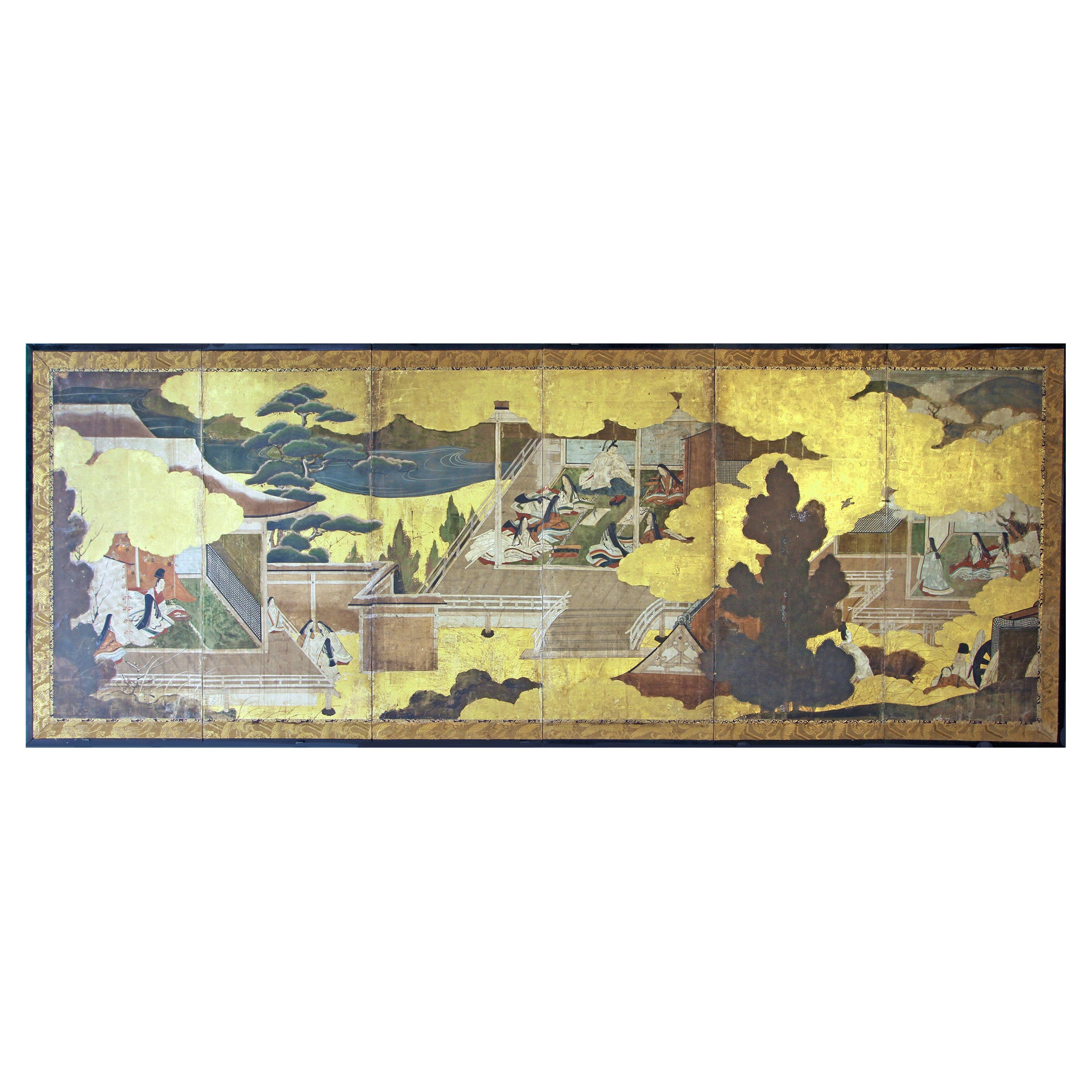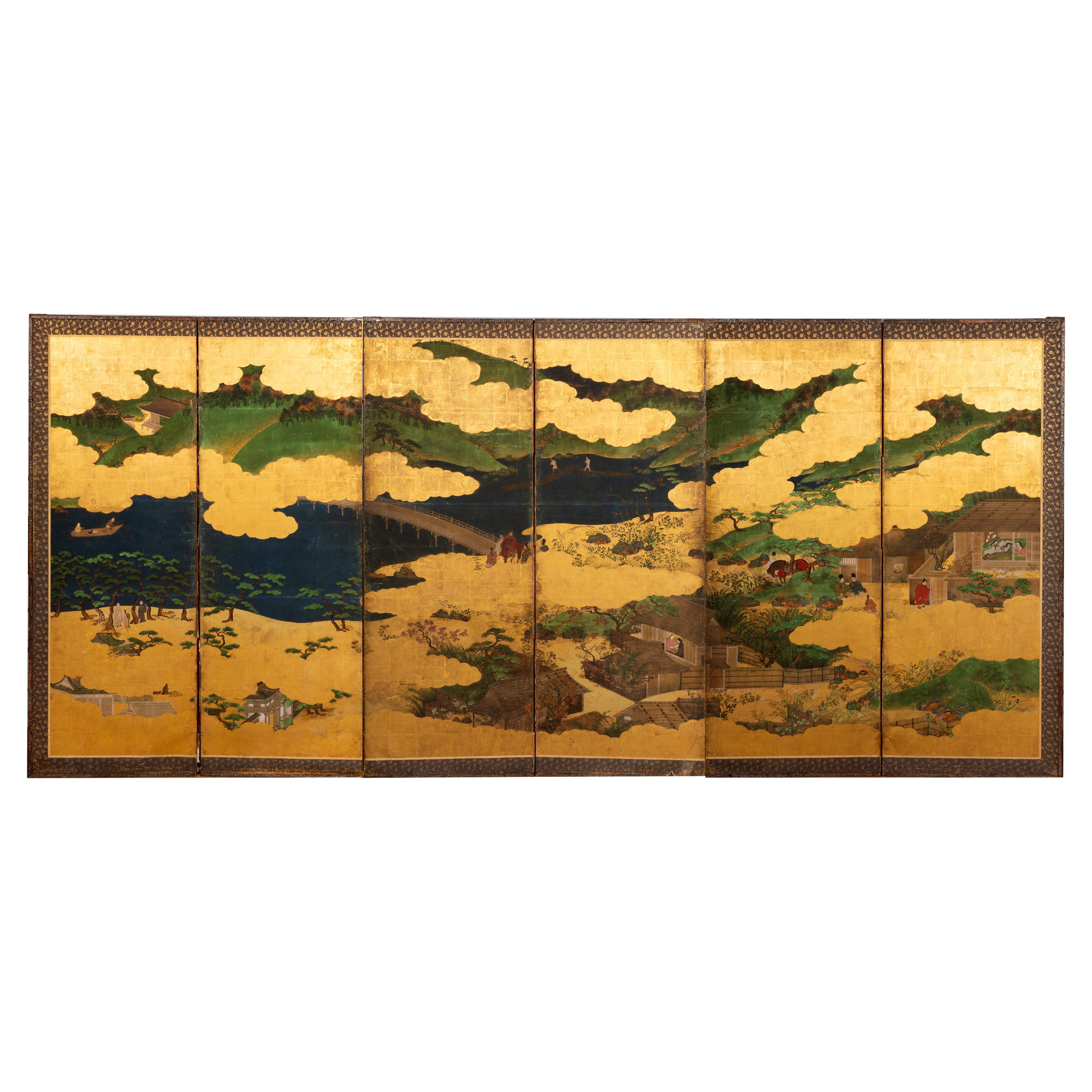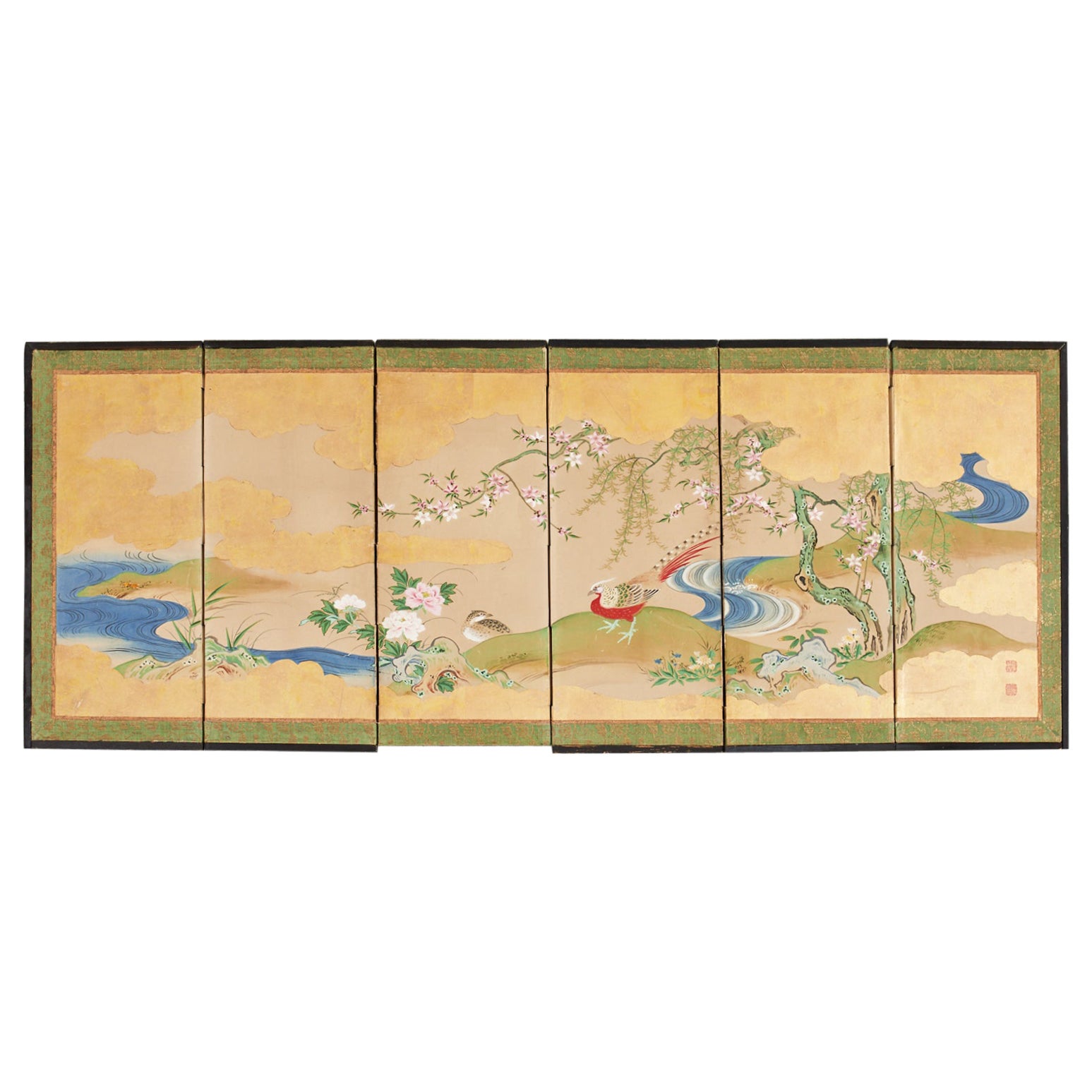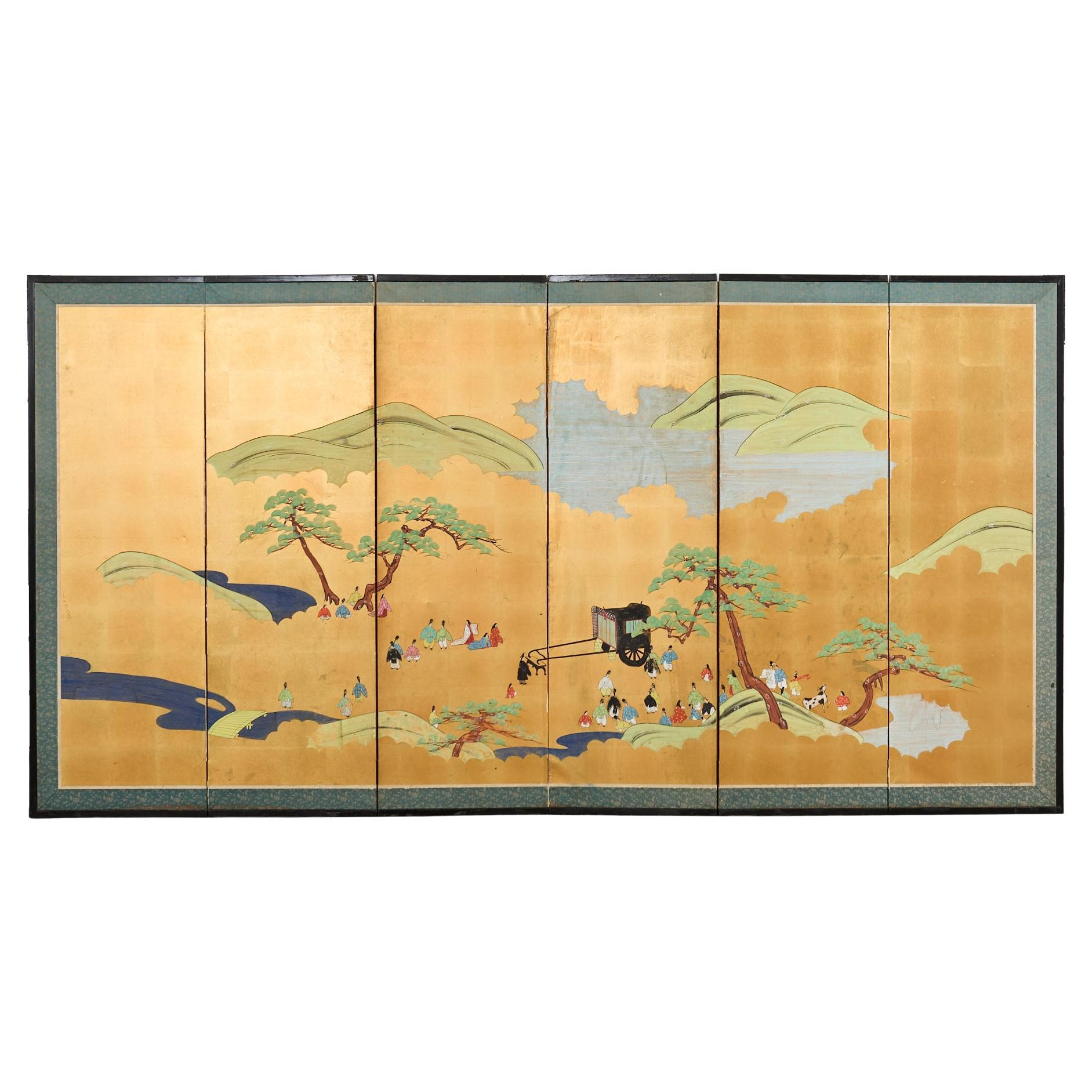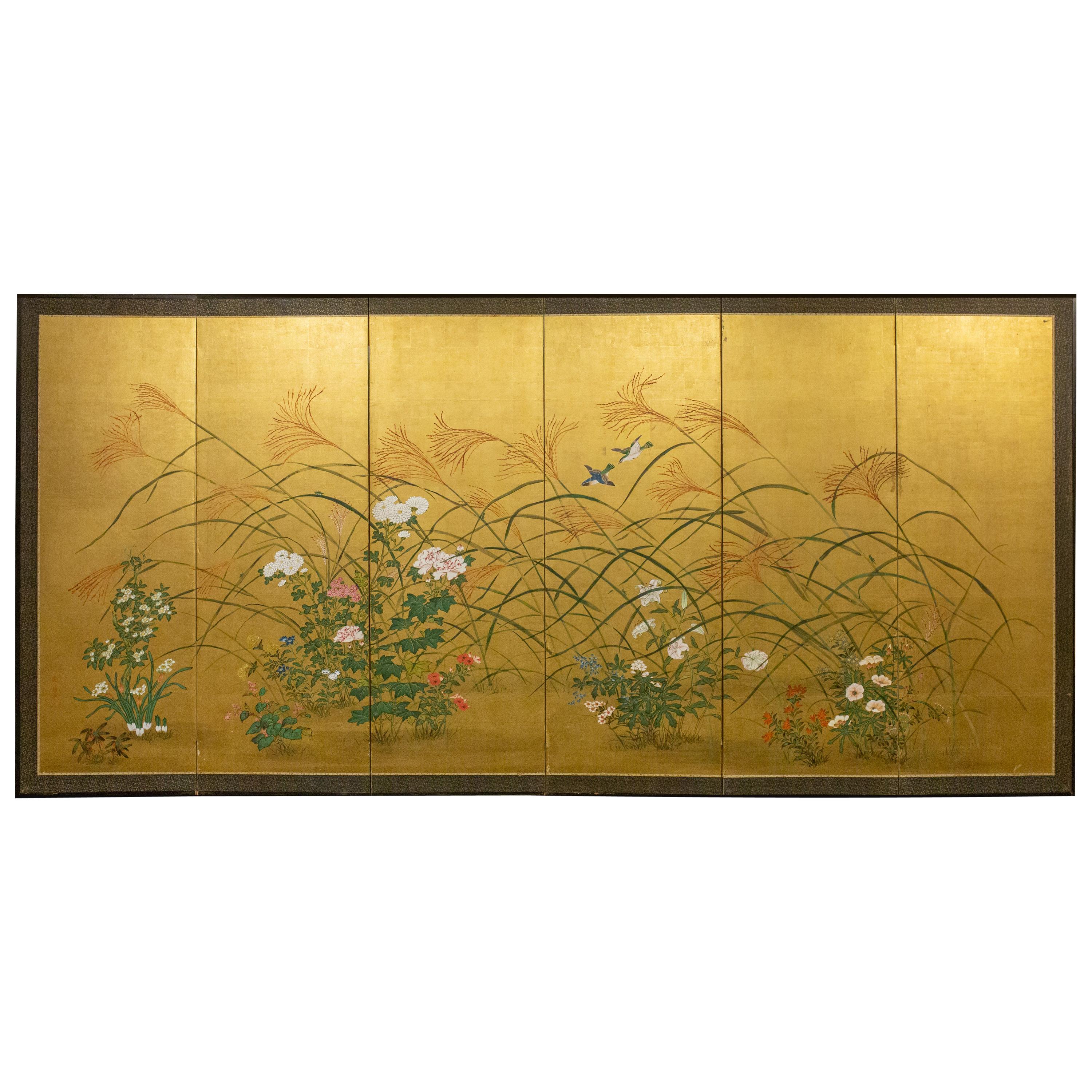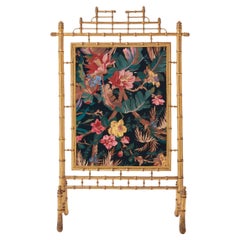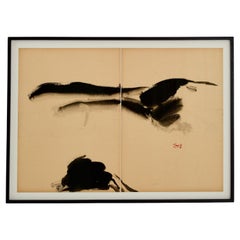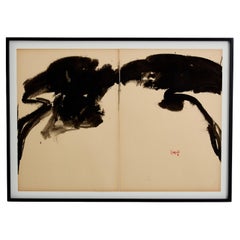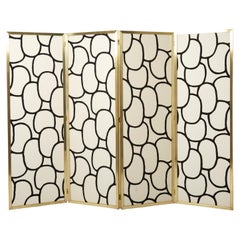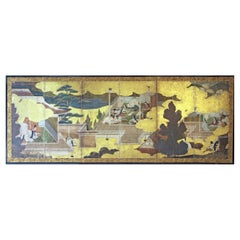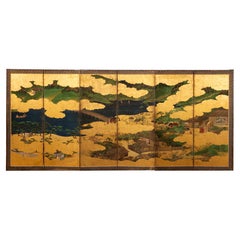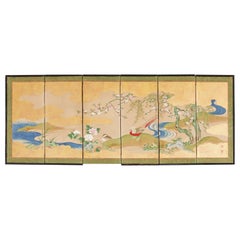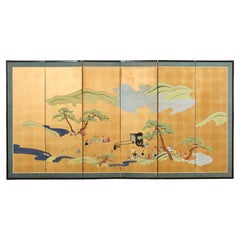Items Similar to Japanese Byobu six panels screen on paper Edo Period 19th century
Want more images or videos?
Request additional images or videos from the seller
1 of 13
Japanese Byobu six panels screen on paper Edo Period 19th century
$25,395.26
£19,080.78
€21,500
CA$34,969.50
A$39,137.32
CHF 20,486.99
MX$475,447.50
NOK 260,132.71
SEK 245,479.64
DKK 163,636.39
About the Item
Beautiful Edo period Japanese Byobu six panel screen from the early 19th century depicting scenes from the Tale of Genji, with pavilions, gardens and women of the court wearing kimonos. It is hand painted with mineral pigments, inks and gold on paper, with red silk borders, mounted on a wood lattice, and within a black lacquer frame. Each panel has been fully cleaned by a specialist, removing the dust and finding back the original colors of the screen. A soft and stretch black cotton fabric has been applied on the back, with Z-shaped hooks mounted on the frame to enable wall mounting. The screen is in very good condition, with very minor wear and color fading.
The Tale of Genji, or Genji Monogatari, was written by a female courtier, Murasaki Shikibu, around the tenth-eleventh centuries. It is a romantic novel that follows the relationships of a legendary Prince Genji and the generation that followed him. Divided into 54 chapters, the English translation by Edward Seidensticker takes up 1,090 pages. The Tale of Genji is required reading in Japanese schools today.
- Dimensions:Height: 67.72 in (172 cm)Width: 148.04 in (376 cm)Depth: 0.79 in (2 cm)
- Style:Japonisme (Of the Period)
- Materials and Techniques:
- Place of Origin:
- Period:
- Date of Manufacture:1820
- Condition:Refinished. Wear consistent with age and use. Paper fully cleaned by a specialist.
- Seller Location:Paris, FR
- Reference Number:1stDibs: LU3020345549052
About the Seller
5.0
Gold Seller
Premium sellers maintaining a 4.3+ rating and 24-hour response times
Established in 2013
1stDibs seller since 2017
205 sales on 1stDibs
Typical response time: <1 hour
- ShippingRetrieving quote...Shipping from: Saint-Ouen-sur-Seine, France
- Return Policy
Authenticity Guarantee
In the unlikely event there’s an issue with an item’s authenticity, contact us within 1 year for a full refund. DetailsMoney-Back Guarantee
If your item is not as described, is damaged in transit, or does not arrive, contact us within 7 days for a full refund. Details24-Hour Cancellation
You have a 24-hour grace period in which to reconsider your purchase, with no questions asked.Vetted Professional Sellers
Our world-class sellers must adhere to strict standards for service and quality, maintaining the integrity of our listings.Price-Match Guarantee
If you find that a seller listed the same item for a lower price elsewhere, we’ll match it.Trusted Global Delivery
Our best-in-class carrier network provides specialized shipping options worldwide, including custom delivery.More From This Seller
View AllFaux bamboo giltwood French decorative firescreen 1960s
Located in Paris, IDF
Highly decorative, this decorative firescreen adds a touch of glam and femininity to a contemporary study, living room, or bedroom. The giltwood structure, carved as bamboo with the ...
Category
Vintage 1960s French Mid-Century Modern Fireplace Tools and Chimney Pots
Materials
Fabric, Bamboo
T’ang Haywen signed diptych ink on beige paper 1970
By Haywen Tang
Located in Paris, IDF
This is a soft diptych ink on kyro board beige paper by Chinese and French ink artist T’ang Haywen, signed, circa 1970. It’s been framed with a black frame and anti-UV glass. The dip...
Category
Vintage 1970s French Mid-Century Modern Paintings
Materials
Paper
T’ang Haywen signed diptych ink on beige paper 1972
By Haywen Tang
Located in Paris, IDF
This is a powerful diptych ink on kyro board beige paper by Chinese and French ink artist T’ang Haywen, signed, circa 1972-1973. It’s been framed with a black frame and anti-UV glass...
Category
Vintage 1970s French Mid-Century Modern Paintings and Screens
Materials
Paper
Galerie Maison et Jardin Four Panel Brass and Silk Fabric Screen, 1970
By Galerie Maison et Jardin
Located in Paris, IDF
Unique 1970s four-panel screen room divider with solid polished brass structure and profile manufactured by Galerie Maison et Jardin in the early 1970s. The panels have been reupholstered with a wool and silk fabric from Fadini Borghi...
Category
Vintage 1970s French Mid-Century Modern Screens and Room Dividers
Materials
Brass
Maurice Dufrêne for La Maitrise art deco tapestry 1922
By La Maitrise, Maurice Dufrêne
Located in Paris, IDF
Maurice Dufrene designed this tapestry for the studio La Maitrise, Les Galeries Lafayette, in Paris in 1922, just as he became the director of the studio. Crafted from handspun wool,...
Category
Vintage 1920s French Art Deco Tapestries
Materials
Wool
René Drouet and Pierre Adrien Ekman Art Deco Lacquered Cabinet 1938
By René Drouet
Located in Paris, IDF
Unique Art deco storage cabinet in dark green lacquer made in 1938 from a collaboration between René Drouet and Pierre Adrien Ekman. It features four ...
Category
Vintage 1930s French Art Deco Cabinets
Materials
Wood
You May Also Like
Japanese Byobu - Japanese screen six panels
By Japanese Studio
Located in Brescia, IT
Six-panel folding screen depicting the famous legend of Hikaru Genji, a nobleman of extraordinary grace and beauty, and his gallant adventures at court.
The novel Genji Monogatari, w...
Category
Antique Early 18th Century Japanese Edo Antiquities
Materials
Gold Leaf
Japanese Six Panel Paper Screen
Located in Essex, MA
Six panel Tosa school with rich colors depicting a river and bridge. Featuring people in various pursuits. Descended in the Thayer family of Massachusetts.
Category
Antique 1750s Japanese Paintings and Screens
Materials
Paper
Japanese Edo Six Panel Table Screen After Maruyama Okyo
Located in Rio Vista, CA
Fantastic diminutive Japanese Edo period table top screen depicting a lively water landscape with flora and fauna. The screen is beautifully painted o...
Category
Antique 19th Century Japanese Edo Paintings and Screens
Materials
Brass, Gold Leaf
Japanese Showa Six Panel Screen Tales of Genji on Gilt
Located in Rio Vista, CA
Early 20th century Japanese showa period six panel byobu screen depicting an artistic reinterpretation of a scene from the tales or Genji Monogatari. The miniature style of the paint...
Category
20th Century Japanese Showa Paintings and Screens
Materials
Silk, Wood, Paper
Important Japanese six-fold screen depicting The Tale of The Genji, 17th century
Located in Amsterdam, NL
An important Japanese six-fold screen, depicting episodes from The Tale of The Genji
Edo period, 17th century
Ink and colour on gilded paper, H. 155 x W. 380 cm
The Tale of Genji...
Category
Antique 17th Century Japanese Edo Paintings and Screens
Materials
Paint, Paper
Japanese Six-Panel Screen, a Garden for All Seasons
Located in Hudson, NY
An imaginary garden with flowers from all seasons including spring lilies, summer hibiscuses, autumn chrysanthemums, and winter berries. Wild autumn grasses move in a soft breeze wit...
Category
Antique 1890s Japanese Meiji Paintings and Screens
Materials
Gold Leaf
More Ways To Browse
Romantic Period Furniture
Japanned English Furniture
Wood Lattice
Antique Fabric Panel
Lattice Panel
Used Lattice Panels
Divider Black Screen
Japanese Wall Fabric
Japanese Six Panel Screen
Garden Pavilion
Antique Japanese Lacquer Screens
Edo Screen Gold
Japanese Kimono Fabric
Asian Paintings On Fabric
Japanese Byobu
Antique Japanese Wall Panels
Byobu Screens
Antique Japanese Black Lacquer Panels
